The struggle to educate Black America
By Nisa Islam Muhammad -Staff Writer- | Last updated: Apr 19, 2017 - 10:18:08 AMWhat's your opinion on this article?
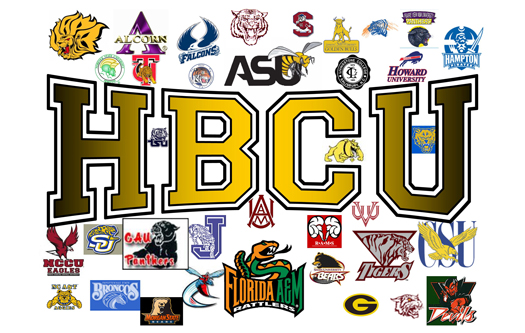
|
The ever-present—ongoing battle—for Black colleges, universities to survive
As the class of 2017 prepares for high school graduation, some students will consider heading to an HBCU, Historically Black College and University, in the fall. These schools bestow 25 percent of undergraduate degrees that Blacks receive annually.
HBCU’s are where many of the best and brightest minds in the Black community have been educated and inspired.
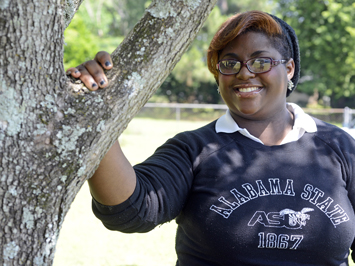
In this photo taken May 23, 2014, Brianna Moore, a computer systems student at Alabama State, poses for a photo in Montgomery, Ala. Photo: AP/Wide World photos
|
“The National Science Foundation reports that 9 of the top 10 institutions graduating Blacks in STEM fields are HBCUs. HBCUs are leading the way in educating African American graduates in scientific, technological, and other fields required for a strong and competitive economy,” said Lezli Baskerville, head of the National Association For Equal Opportunity in Higher Education (NAFEO). It is an organization that represents HBCU presidents and chancellors.
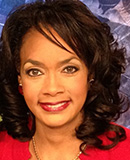
Lezli Baskerville, head of the National Association For Equal Opportunity in Higher Education
|
Inadequate funding remains a key reason why many of the nation’s top Black institutions for higher learning continue to struggle.
Fight for funding in Maryland
Fed up with the state of Maryland’s lack of progress in equitable funding given to its four HBCUs the Legislative Black Caucus sponsored HBCU Night in Annapolis, Md., last month to organize support for SB-712, The Blount-Rawlings-Britt HBI Comparability Program which gives more funding to make the state’s HBCUs “comparable and competitive.”
“It’s a political fight; it always has been,” said Cheryl Glenn, chair of the Legislative Black Caucus. “Thank God we have a Black Caucus 50 members strong and counting. Those of us who are here are solidly united on our priority agenda and HBCU’s are at the top of our agenda,” she added. “No matter what else we’re doing, our HBCU’s come first.”
For decades advocates in Maryland’s Black community have been fighting for additional funding for Bowie State University, Coppin State University, Morgan State University and the University of Maryland-Eastern Shore.

|
Two more failed desegregation plans were devised and finally in 2006, the Coalition for Equity and Excellence in Maryland Higher Education, a community group composed of alumni from Maryland’s HBCUs, filed a lawsuit that “asserts that the State of Maryland violated HBCU students’ rights under Title VI of the Civil Rights Act of 1964 and the Equal Protection Clause of the U.S. Constitution’s 14th Amendment—i.e. Maryland continues to operate a system of higher education that discriminates against HBCU students.”
According to court documents, Judge Catherine E. Blake ruled in favor of the HBCU plaintiffs in 2013, determining that Maryland continues to operate a system of discrimination against HBCUs.
“Students who enter Maryland’s historically Black institutions—whether Black, White, or of other races—do not have an equal educational opportunity as those students who attend the state’s traditionally White institutions,” she wrote in her opinion.
Court documents show that she ordered the HBCU plaintiffs and State of Maryland to create a remedy for the discriminatory pattern of academic program duplication that put HBCUs at a disadvantage. The plaintiffs submitted a plan. But the State of Maryland failed to submit a comprehensive plan.
For the next two years, attempts to reach a mediation that gives fair and equitable funding to state HBCUs and reduces program duplication were held. Mediation failed and in December 2016, Judge Blake ordered the coalition and state to return to court for trial in 2017. That hearing is scheduled for June.
Once again, as it has for the past 12 years, the Legislative Black Caucus introduced Senate Bill-712, The Blount-Rawlings-Britt HBI Comparability Program. This bill would “provide supplemental funding assistance to the State’s HBCUs by requiring the Maryland Higher Education Commission to adopt certain standards and procedures; requiring the Governor to provide funds for the Commission to distribute to HBCUs; providing for the calculation of the annual operating budget distribution to each of the HBCUs; providing for the annual distribution of certain capital funds to the HBCUs.”
The bill has never moved forward and the Legislative Black Caucus believes coalition building is the answer. The bill requests an additional $5 million in spending for the state’s HBCUs. HBCU Night in Annapolis brought together potentially new supporters.
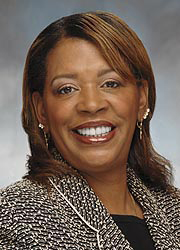
Senator Joan Carter Conway
|
“You’ve got to stand united here,” Ms. Conway told the audience. “We’re not always united and that’s what takes a little long. You need to be calling budget and tax (committees) every day like they call me about fracking,” Ms. Conway added. “You’ve got to call and call and call and call. From this day forward and every day until the day they bring the bill.”
She further explained that the Senate Budget and Tax committee must refer SB-712 to the full Senate for the bill to remain under consideration in the current legislative session, which ended in mid-April.
Elizabeth Proctor represents significant Black populations in the state’s Prince Georges and Charles Counties. She explained that the strategy this year is for the Legislative Black Caucus to work with other legislative caucuses.
“We’re now joining with the Hispanic Caucus and the Asian Caucus. We’re attempting to pull everyone together which will give us more than the number of votes needed. If we can get everyone to work together we’ll be in a very positive place,” she said.
“When I look at the other colleges in Maryland and the way they come down (to Annapolis). They’re not asking, they’re demanding for their colleges. We don’t have the same level of demand from the colleges here. We’re too accustomed to going along to get along.”
Battle on the federal level
On Feb. 27 of this year, HBCU presidents and chancellors were lured to the White House with promises of additional funding much to the chagrin of many students, faculty and alumni. President Trump signed an Executive Order that day transferring oversight of a federal HBCU initiative from the Department of Education directly to the White House. But all that pomp and circumstance seems to have been more smoke and mirrors than anything substantial when the president’s budget was released March 16.
The president’s proposed budget called for a $9.2 billion cut to the U.S. Department of Education but maintains the amount allocated to HBCUs of $492 million the same amount under the Obama administration.
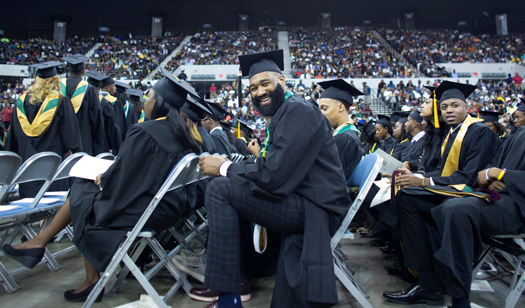
Former Norfolk State University basketball star Kyle O'Quinn, now playing with the New York Knicks, smiles and waits during Norfolk State University's commencement ceremony at the Norfolk Scope in Norfolk, Va., May 7, 2016. Photo: AP/Wide World photos
|
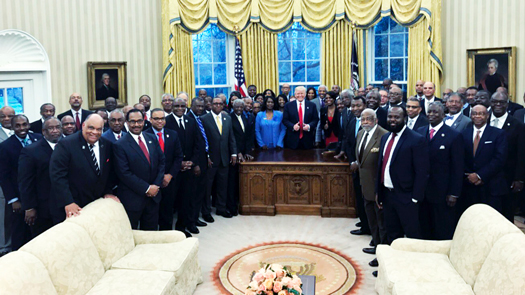
President Donald Trump poses with leaders of dozens of historically Black colleges and universities (HBCU) in the Oval Office at the White House in Washington, D. C. February 27. Photo: Twitter/@Scavino45
|
“We’ve heard all of this talk from President Trump about African Americans not having anything to lose under his Administration. The truth is that we have a lot to lose and his budget proposal is proof of that,” wrote Congressional Black Caucus Chair Cedric Richmond (D-La).
“Although President Trump promised a ‘New Deal for Black America,’ his budget slashes the federal workforce and cripples domestic programs (e.g. federal student services TRIO programs, LIHEAP, grants for after school programs, Community Development Block Grants, and Community Services Block Grants), and we’re likely to see even more cuts in these areas if he gives tax breaks to the wealthy, as expected.”
He added, “All of this hurts the African-American community. In addition, despite his promise to support and strengthen HBCUs, President Trump proposes to give these schools the same amount of funding they received last year. This budget proposal is not a new deal for African Americans. It’s a raw deal that robs the poor and the middle-class to pay the richest of the rich.”
Alumni giving could offset many of the financial needs of HBCUs. According to US News and World Report, Claflin University, has the highest rate of alumni giving with an average of 48.9 percent of alumni donating during the 2012-2013 and 2013-2014 school years.
It had the highest percentage of alumni who donated among 46 HBCUs that submitted data to U.S. News in an annual survey. Bennett College, an all-women’s school, is right behind Claflin with an average of 38.2 percent of alumni who donated during a two-year period. Fisk University, where NAACP co-founder W.E.B. Du Bois attended, had an average of 23.9 percent of alumni who donated.
Alumni giving can create programs and help with financial aid to needy students. However, too many alumni don’t give and those donations are desperately needed.
“My research shows that HBCU alumni do give back when asked, however, they have to be educated about philanthropy,” explained Marybeth Gasman, professor of higher education at the University of Pennsylvania and author of “A Guide to Fundraising at Historically Black Colleges and Universities: An All Campus Approach.”
“African Americans prefer to give to concrete causes, want to be thanked and need to understand where their donations are going. African Americans give more of their discretionary income than any other racial or ethnic group, including Whites. Sixty percent of that goes to the church, but a good amount goes to education and youth programs.”
Students who attend HBCUs report tangibles in addition to a first rate education that can’t be received attending majority White schools. According to the United Negro College Fund, the Black schools offer:
A Supportive Atmosphere and Community
• With HBCUs’ special focus, your college experience will be one surrounded by many people with similar backgrounds and cultural experiences. You’ll experience a unique community of support and understanding among faculty and your fellow students.
Diversity
• A focus on African American students doesn’t mean a restricted cultural experience. HBCUs and HSIs (Hispanic-serving institutions) educate students of all races, ethnicities and cultures from around the world.
Affordability
• In 2013-2014, the average total cost of attendance at all HBCUs was 26 percent lower than the average total cost at all four-year non-profit colleges.
Alumni Support and Networking
• Most HBCUs and HSIs have strong and active alumni associations that provide you ongoing support and valuable networking opportunities to help you develop your future career.
“HBCUs provide a stable and nurturing environment for those most at risk of not entering or completing college: low-income, first-generation college students. Many of these students are academically underprepared for college, yet they’re precisely the students that the country most needs to obtain college degrees,” said Dr. Michael Lomax, UNCF president and CEO.
“On average, more than 300,000 students attend HBCUs each year, and 80 percent of them are African Americans. It’s also worth noting that HBCUs are serving those who need it the most — more than 70 percent of all students at HBCUs qualify for federal Pell Grants and 80 percent of HBCU students receive federal loans,” he said.
INSIDE STORIES AND REVIEWS
-
-
About Harriett ... and the Negro Hollywood Road Show
By Rabiah Muhammad, Guest Columnist » Full Story -
Skepticism greets Jay-Z, NFL talk of inspiring change
By Bryan 18X Crawford and Richard B. Muhammad The Final Call Newspaper @TheFinalCall » Full Story -
The painful problem of Black girls and suicide
By Charlene Muhammad -National Correspondent- » Full Story -
Exploitation of Innocence - Report: Perceptions, policies hurting Black girls
By Charlene Muhammad -National Correspondent- » Full Story -
Big Ballin: Big ideas fuel a father’s Big Baller Brand and brash business sense
By Bryan Crawford -Contributing Writer- » Full Story






 Click Here Stay Connected!
Click Here Stay Connected!








